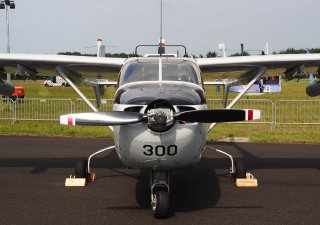Cessna O-2 Skymasters: This Low-Cost Twin-Engine Aircraft Was a Master of the Sky
Today surviving Cessna O-2 Skymasters are in the collections of numerous museums.
With a name like the Skymaster one might envision a super-heavy bomber loaded with advanced armaments, or perhaps the fastest fighter to fly into the wild blue yonder. However, the Cessna O-2 Skymaster – which was also affectionately nicknamed “Oscar Deuce”—was neither. It was primarily used for forward air control (FAC) and psychological operations (PYSOPS) and by most accounts, it excelled in both.
During the Vietnam War in late 1966, the United States Air Force selected a military variant of the Cessna Model 337 Super Skymaster to supplement the aging O-1 Bird Dog for use as a FAC aircraft to operate in Southeast Asia. The low-cost, twin-engine piston-powered aircraft featured the unique push-pull configuration with one engine in the nose and a second in the rear of the fuselage. That offered advantages for the pilots, notably that it provided a clear observation below and behind the aircraft, while the twin engines also enabled the O-2 to absorb more ground fire and still return safely to base. The seats were also armored to protect the crew.
In its FAC capacity, the Skymaster ensured that air attacks would be aimed at the intended target and not come down on friendly troops. While the Cessna O-2 wasn’t the only FAC aircraft, and the U.S. Air Force relied on a number of other aircraft including the A-26 Invader, C-123 Provider and the Lockheed AC-130 in a similar role, the Skymaster proved well suited to the task.
A total of 532 O-2s were built for the Air Force in two series—the O-2A and O-2B. The former carried wing pylons for rockets, flares and other light ordnance and in its FAC role it could identify and mark enemy targets with smoke rockets, coordinate airstrikes and even report target damage. The O-2B version operated in a completely different role, one of PYSOPS, where it was equipped with loudspeakers and leaflet dispensers. That version of the aircraft carried no ordnance.
Both versions of the Skymaster were powered by two 210hp Continental 10-360s engines and had a maximum speed of 199 miles per hour, a range of 1,060 miles and a ceiling of 19,300 feet, but in practice, the Skymaster tended to fly just above the treetops. The aircraft had a crew of two, a pilot and observer.
Following the Vietnam War, the O-2 remained in service with the U.S. Air Force and Air National Guard, and in the 1980s six of the former aircraft were transferred to the U.S. Navy, where the Skymaster was used as “range controller.” The aircraft remained in that role until September 1990 when they were replaced by the T-34C Turbo Mentor. Two of the Vietnam War-era O-2s were used in air shows in the 1990s performing the “Viet Nam Warbird COIN/FAC” routine, which made its debut at the “Wings Over Houston” air show in October 1991.
Today surviving Cessna O-2 Skymasters are in the collections of numerous museums including the National Museum of the United States Air Force, the Fort Worth Aviation Museum, the Pima Air and Space Museum, the Evergreen Aviation Museum and the Yankee Air Museum.
Peter Suciu is a Michigan-based writer who has contributed to more than four dozen magazines, newspapers and websites. He is the author of several books on military headgear including A Gallery of Military Headdress, which is available on Amazon.com.

